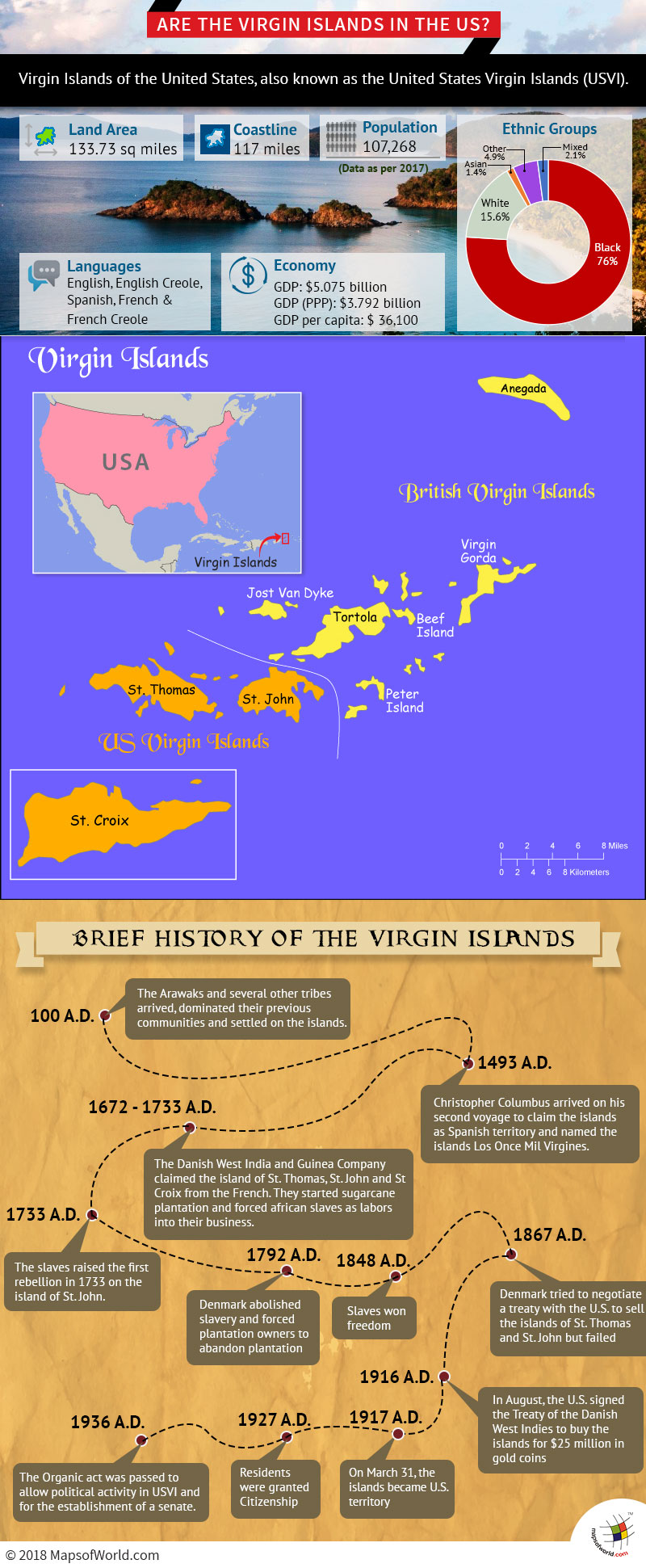Is the Virgin Islands in the US?
The Virgin Islands, also known as the United States Virgin Islands (USVI), is an unincorporated and organized territory of the United States of America. The USVI is a territory of the US, but not a state. All residents of the islands are citizens of the United States.
Location
The USVI is located 40 miles east of Puerto Rico and west of the British Virgin Islands between the Caribbean Sea and the North Atlantic Ocean. The three major islands of USVI are St Thomas, St. John and St. Croix.
Land Area: 133.73 sq. miles (346.36 sq. km)
Coastline: 117 miles (188 km)
Capital: Charlotte Amalie
Population: 107,268 – 2017 estimate
Ethnic Groups: Black – 76%, White – 15.6%, Asian – 1.4%, Other – 4.9%, mixed – 2.1%
Languages: English, English Creole, Spanish, French and French Creole
Economy:
- GDP: $5.075 billion (2013 est.)
- GDP (PPP): $3.792 billion (2013 est.)
- GDP per capita: $ 36,100 (2013 est.)
Administrative and Political Structure
The Governor is the head of the local government and along with the Lieutenant Governor, is elected to office by popular vote for a term of four years.
The Legislature of the Virgin Islands is a 15-member unicameral body comprising seven elected Senators from the district of St. Croix, seven Senators from the districts of St. Thomas and Saint John. One member is Senator-at-large and must be a resident of Saint John. All are elected to serve a two-year term with no limitation on the number of terms they serve.
The residents of USVI cannot vote to elect the US President since it is a territory and not a state, but residents have the right to participate in the nomination process of the US Presidential candidates.
If a USVI resident becomes a resident of one of the 50 states, then the person can cast his or her vote in all elections, similar to the rights enjoyed by residents of all 50 states. If a resident of one of the 50 states becomes a resident of USVI, then that person loses the right to cast an electoral vote in the U. presidential election or the election process of the Congress.
The USVI sends one Representative as a Delegate to the House of Representatives. The delegate cannot vote during the passage of Bills in the House but can introduce bills, suggest amendments or speak on the floor.
The USVI has an independent judiciary with a Supreme Court, a Superior Court, and a District Court. The Supreme Court comprises of three justices, all appointed by the Governor for a ten-year term and confirmed by the legislature. The US Supreme Court hears all appeals of the Supreme Court of Virgin Islands.
A brief history of the Virgin Islands
The Ciboneys were the first to inhabit the islands. The Indian tribe called Arawaks arrived around 100 AD and settled on the island of St. John and St. Croix. Later, another Indian tribe – the Caribs, arrived and dominated the local communities. Following this, the Tainos landed to make these islands their home.
In 1493 Christopher Columbus arrived on his second voyage to claim the islands as Spanish territory. He named the islands Los Once Mil Virgines, after St. Ursula and her eleven thousand virgins. He changed the island’s name from Ay Ay to Santa Cruz.
By the late 1500s, several Europeans settlers began to arrive and dominate the local Indian tribes. In 1672, the Danish West India and Guinea Company claimed the island of St. Thomas; St. John by 1694; and St Croix from the French in 1733.
The European settlers began growing sugarcane to produce sugar and needed labor to run the plantations. African labor was forcefully brought from the African continent and sold into slavery.
Soon, the USVI became a rich and prosperous plantation territory creating wealth for the European settlers. Living under oppressive conditions, the slaves raised the first rebellion in 1733 on the island of St. John. In 1792, Denmark announced the abolition of slavery. Many plantation owners did not accept this, but the strict laws forced several owners to abandon their plantations.
What was once a prosperous economy slowly began to stagnate. The slaves won their freedom in 1848, but the islands remained economically weak.
In 1867, the government in Denmark tried to negotiate a treaty with the US to sell the islands of St. Thomas and St. John, but failed.
It took the active role played by German submarines during the World War 1, and the possibility of Germany using the islands to attack the US that brought back interests of the US back to the negotiating table with Denmark. In August 1916, the US signed the Treaty of the Danish West Indies to buy the islands for $25 million in gold coins (around $563 million in 2017).
On March 31st, 1917, the islands became US territory. Residents were granted Citizenship in 1927. In 1936, the Organic act was passed to allow political activity in the USVI for the establishment of a senate. The USVI got its first local Governor, Melvin H. Evans in 1970.
Present Economy
The local economy is sustained mainly through tourism, and the several islands make a great holiday destination for residents from the mainland and international holidaymakers. Fishing and farming are the other activities.
Popular Events
The islands are famous for their Carnivals. The Christmas festival and the Three Kings Day Adult parade in December mark the beginning of carnival time in St. Croix. The St. Thomas carnival and the Fourth of July parade in St. Croix are also very popular with the locals and tourists.
Snorkeling and scuba diving in St. John’s North Shore; Virgin Islands National Park; the Cruzan Rum Distillery are all popular experiences in USVI.
Visit the following to learn more about the Virgin Islands:
Related Maps:




